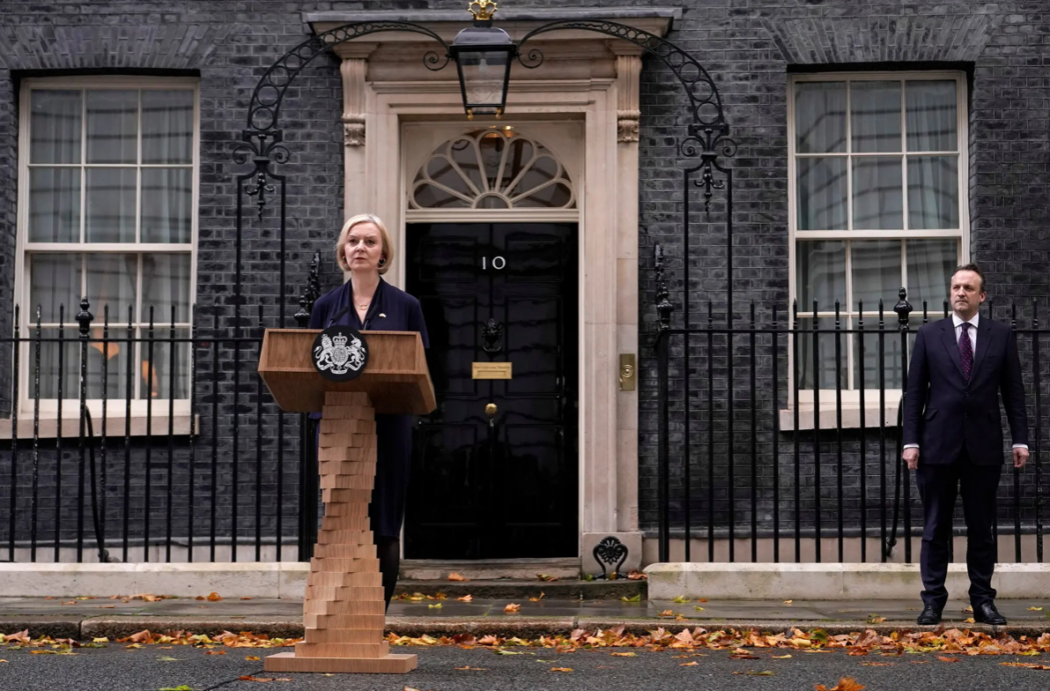If you’ve been looking at international news recently, you probably have seen a lot of developments in the United Kingdom. This year has been filled with political turmoil and leadership changes, both in the royal family and the U.K. Parliament. Recently, we have been seeing troubles when it comes to keeping a prime minister, as the nation has had five prime ministers in the last six years, with three different people in the position in the last four months alone.
On Oct. 20, Prime Minister Liz Truss of Britain announced her resignation. The troubled premier only held office for 44 days, making her tenure the shortest in British history. Her six-week stint in the position was filled with political and economic turmoil that descended into chaos. By the end, Truss had become so unpopular that even her own party was figuring out ways to replace her. The British people agreed, with a YouGov poll showing that Truss’s net favorability rating stood at -70 percent by the end of her tenure.
What happened to Liz Truss?

Truss was appointed as prime minister on Sept. 6. after members of the Conservative Party chose her to replace Boris Johnson following his resignation in July. Queen Elizabeth II appointed her just days before the monarch’s death. Truss’ first two weeks in office were overshadowed by the death of Queen Elizabeth II and as the country entered a period of mourning, politics were muted. Truss and her political party, weren’t really in the news. Several missteps caused this to change dramatically in the coming weeks.
On Sept. 23, the problems started. Truss’ finance minister, Kwasi Kwarteng, announced a so-called mini-budget, unveiling a significant change in the country’s economic strategy. Kwarteng’s plan included promises to slash taxes for the highest earners and biggest corporations in the country — but it didn’t include any plans for how to pay for it. The mini-budget began a period of turmoil in the U.K. as bond markets resisted these debt-funded tax cuts. Almost immediately, the British Pound’s valuation dropped and the central bank was forced to increase interest rates to help. This rise in inflation, which was already at record highs, raised the average standard of living, caused mortgage rates to skyrocket and further led to a lot of distrust in the Conservative Party.

The financial turmoil forced Truss to replace her Treasury chief and reverse course on her tax-cutting plan. The original announcement said the budget would cut taxes by 45 billion pounds ($50 billion); Truss canceled about 20 billion pounds of the originally planned tax cuts as a result of the rising inflation rate and the drop in valuation of the British Pound. She also sacked Kwasi Kwarteng and replaced him with Jeremy Hunt, who immediately reversed most of the policies Kwarteng had created during his tenure.
The Wednesday before announcing her resignation, Truss had declared her fitness for office saying, “I’m a fighter, not a quitter,” during the weekly Prime Minister’s Questions session. However, it’s hard to lead a party without respect or credibility and, at this point, Truss had neither. A day later, she resigned as prime minister but said she would stay in power until the party chose a successor.
While the resignation was the most shocking moment of the week, it was just another jolt in a week full of seismic developments in the U.K. The week included the ousting of Truss’ chancellor of the Exchequer, Kwasi Kwarteng; the bitter departure of the home secretary, Suella Braverman; and a breakdown of discipline within the Conservative Party. Truss’ final day in office was also met with controversy and marked by a chaotic vote on fracking. A near commotion occurred as cabinet ministers tried to force members of the Conservative Party to back the prime minister in a vote on whether to ban hydraulic fracking. The chaotic event ended in members of Parliament claiming they had been manhandled by Truss’ supporters into voting with her government. The spectacle showed just how little control Truss had over her party and the government and the next morning she announced her resignation.
What’s Happening Now?

After a chaotic three-day race to become the leader of Britain’s Conservative Party following Truss’ resignation, a new leader is in power. Rishi Sunak lost his first bid for prime minister to Truss less than two months ago, but he now will be remembered for having one of the best comebacks in British political history and it is not surprising why. The former finance minister was the top choice among fellow Conservative Party members to succeed Boris Johnson back in July, but Truss was ultimately the favorite among the Conservative Party’s grassroots members — who typically get the final say in who comes to power. This time around, Sunak secured support from nearly 200 Conservative Party members, beating Johnson and Penny Mordaunt and thus avoiding a runoff vote that would have occurred on that Friday.
Sunak is the first person of color to become prime minister in British history. He is not only the first non-white leader, but he is also the nation’s first Asian and Hindu premier. Party members expect Sunak to pull Britain back to more mainstream politics following Truss’ failed attempt at trickle-down economics. They also expect him to lead much differently than the often erratic behavior of Boris Johnson. While there are high expectations for the former chancellor of the Exchequer, Sunak will confront some major problems. He enters office during one of the gravest economic crises in British history and at a time when his Conservative Party is still healing from internal rifts.
Sunak will become Britain’s third prime minister in seven weeks, the youngest in two centuries and the first person of the Hindu faith to hold this position. As a former investment banker, he will also be one of the wealthiest people ever to occupy 10 Downing Street (the official residence and office of the prime minister). This could pose problems, with the country set to go through an economic downturn that could affect millions of people





